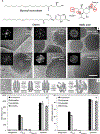Nanometer- and angstrom-scale characteristics that modulate complement responses to nanoparticles
- PMID: 36152807
- PMCID: PMC10200249
- DOI: 10.1016/j.jconrel.2022.09.039
Nanometer- and angstrom-scale characteristics that modulate complement responses to nanoparticles
Abstract
The contribution of the complement system to non-specific host defence and maintenance of homeostasis is well appreciated. Many particulate systems trigger complement activation but the underlying mechanisms are still poorly understood. Activation of the complement cascade could lead to particle opsonisation by the cleavage products of the third complement protein and might promote inflammatory reactions. Antibody binding in a controlled manner and/or sensing of particles by the complement pattern-recognition molecules such as C1q and mannose-binding lectin can trigger complement activation. Particle curvature and spacing arrangement/periodicity of surface functional groups/ligands are two important parameters that modulate complement responses through multivalent engagement with and conformational regulation of surface-bound antibodies and complement pattern-recognition molecules. Thus, a better fundamental understanding of nanometer- and angstrom-scale parameters that modulate particle interaction with antibodies and complement proteins could portend new possibilities for engineering of particulate drug carriers and biomedical platforms with tuneable complement responses and is discussed here.
Keywords: Antibodies; C1q; Complement system; Dendrimers; Factor H; Mannose-binding lectin; Nanoparticles.
Copyright © 2022 The Authors. Published by Elsevier B.V. All rights reserved.
Conflict of interest statement
Declaration of Competing Interest S.M.M. & P.N.T. are named inventors on PCT, EPO and US patent filings on dendrimers. P.N.T. declares financial interests in CosmoPHOS Ltd. (Greece). H.B.H., A.Y. & D.S. declare that they have no competing financial interests or personal relationships that could have appeared to influence the work reported in this paper.
Figures






Similar articles
-
Dendrimer end-terminal motif-dependent evasion of human complement and complement activation through IgM hitchhiking.Nat Commun. 2021 Aug 11;12(1):4858. doi: 10.1038/s41467-021-24960-6. Nat Commun. 2021. PMID: 34381048 Free PMC article.
-
Activation of the complement system by nanoparticles and strategies for complement inhibition.Eur J Pharm Biopharm. 2023 Dec;193:227-240. doi: 10.1016/j.ejpb.2023.11.006. Epub 2023 Nov 8. Eur J Pharm Biopharm. 2023. PMID: 37949325
-
Interactions of the humoral pattern recognition molecule PTX3 with the complement system.Immunobiology. 2012 Nov;217(11):1122-8. doi: 10.1016/j.imbio.2012.07.004. Immunobiology. 2012. PMID: 22964239 Review.
-
Interaction of Complement Defence Collagens C1q and Mannose-Binding Lectin with BMP-1/Tolloid-like Proteinases.Sci Rep. 2017 Dec 5;7(1):16958. doi: 10.1038/s41598-017-17318-w. Sci Rep. 2017. PMID: 29209066 Free PMC article.
-
The Immunopathology of Complement Proteins and Innate Immunity in Autoimmune Disease.Clin Rev Allergy Immunol. 2020 Apr;58(2):229-251. doi: 10.1007/s12016-019-08774-5. Clin Rev Allergy Immunol. 2020. PMID: 31834594 Review.
Cited by
-
Strategies to reduce the risks of mRNA drug and vaccine toxicity.Nat Rev Drug Discov. 2024 Apr;23(4):281-300. doi: 10.1038/s41573-023-00859-3. Epub 2024 Jan 23. Nat Rev Drug Discov. 2024. PMID: 38263456 Review.
-
Mechanisms and Barriers in Nanomedicine: Progress in the Field and Future Directions.ACS Nano. 2024 Jun 4;18(22):13983-13999. doi: 10.1021/acsnano.4c00182. Epub 2024 May 20. ACS Nano. 2024. PMID: 38767983 Free PMC article.
-
A percolation phase transition controls complement protein coating of surfaces.Cell. 2025 Jul 24;188(15):4058-4073.e25. doi: 10.1016/j.cell.2025.05.026. Epub 2025 Jun 13. Cell. 2025. PMID: 40516526 Free PMC article.
-
Lipid and Transcriptional Regulation in a Parkinson's Disease Mouse Model by Intranasal Vesicular and Hexosomal Plasmalogen-Based Nanomedicines.Adv Healthc Mater. 2024 Jun;13(14):e2304588. doi: 10.1002/adhm.202304588. Epub 2024 Feb 28. Adv Healthc Mater. 2024. PMID: 38386974 Free PMC article.
-
Perspectives on complement and phagocytic cell responses to nanoparticles: From fundamentals to adverse reactions.J Control Release. 2023 Apr;356:115-129. doi: 10.1016/j.jconrel.2023.02.022. Epub 2023 Mar 2. J Control Release. 2023. PMID: 36841287 Free PMC article.
References
-
- Haapasalo K, Vuopio J, Syrjänen J, Suvilehto J, Massinen S, Krappelin M, Järvelä I, Meri S, Kere J, Jokiranta TS, Acquisition of complement factor H is important for pathogenesis of Streptococcus infections: evidence from bacterial in vitro survival and human genetic association, J. Immunol 188 (2012) 426–435. - PubMed
Publication types
MeSH terms
Substances
Grants and funding
LinkOut - more resources
Full Text Sources

